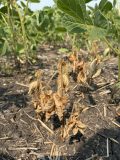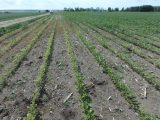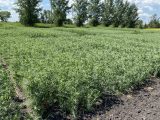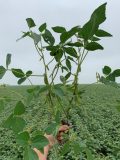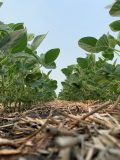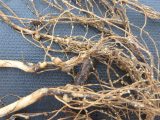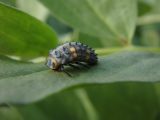July 21, 2021
- Crop Update
- Soybean Cyst Nematode Update for Manitoba
- Pea Desiccation and Harvest
- Soybean Stem Diseases
- Dry Bean Fungicide Decisions
- Beneficial Insects: Natural Enemies of the Soybean Aphid
- On-Farm Network Update – Dry Bean Discoveries in a Dry Year
Listen to The Bean Report:
Crop Update
 Soybeans are setting and filling pods at the R3 to R4 stages. Most fields are showing some signs of drought stress, which mainly presents as flipped leaves during the day to reflect the sun and conserve a bit of moisture. That said, there is still a lot of potential for this year’s soybean crop at this stage. Critical water uptake for soybeans is during pod formation and fill, so yield will be determined over the coming weeks. There were some scattered showers around western and central Manitoba over the weekend, and over some central areas on Monday and Tuesday. Hopefully we’ll continue to see more.
Soybeans are setting and filling pods at the R3 to R4 stages. Most fields are showing some signs of drought stress, which mainly presents as flipped leaves during the day to reflect the sun and conserve a bit of moisture. That said, there is still a lot of potential for this year’s soybean crop at this stage. Critical water uptake for soybeans is during pod formation and fill, so yield will be determined over the coming weeks. There were some scattered showers around western and central Manitoba over the weekend, and over some central areas on Monday and Tuesday. Hopefully we’ll continue to see more.
- Could there be a possibility of greater drought tolerance in soybeans this year? Researchers have found that if soybeans were subjected to water stress during V4, they had an increased tolerance to water shortages later in life. Conditions were certainly dry during that period of soybean development, so perhaps these more resilient plants will be able to carry on despite the dry conditions and maximize what they can produce from the moisture that is available.
- Hail accompanied recent rains in some areas of the province. Research from the soybean and pulse agronomy lab has determined that soybeans are most sensitive to leaf loss during R4 and R5. Yield loss varies with the amount of leaf defoliation (Table 1), ranging from 4-62% yield loss at R3 (early pod) and 13-75% yield loss at R4 (full pod). If less than a third of the canopy has been damaged or shredded, then yield loss is expected to be below 13%.
- Soybean aphids were confirmed two weeks ago in central Manitoba at very low levels. These aphids blow in from the south, so populations remain quite low here and in North Dakota. Field populations of beneficial predators appear to be offering control.
- Grasshoppers continue to be the main pest of concern. Note that defoliation thresholds change at later reproductive stages: for soybeans at bloom to pod fill stages it’s 15% defoliation and for more advanced soybeans at pod fill to maturity the threshold is 25% defoliation, unless pod feeding is observed.
Dry beans range from R2 to R3, forming pods that are pin beans to pods that are about an inch or more long. Continue to scout and assess the risk of white mould development now that there has been some precipitation. The R2/early pin bean stage is the best time for fungicide applications. So far, spraying has been minimal, limited to fields with thick canopies in regions with more moisture and minimal winds.
Field peas have full pods and are maturing rapidly, ranging from R4 to R5, and even reaching R6 in some fields. Hot, dry conditions have caused some seeds within pods to abort, resulting in fewer seeds per pod. Peas are maturing rapidly in part due to earlier seeding dates but due to moisture limitations. Harvest is expected to begin shortly.
Faba beans have full pods in some areas, sitting mainly at the R5 stage. Some symptoms of disease are showing up in the lower canopy.
Soybean Cyst Nematode Update for Manitoba
Another case of soybean cyst nematode (SCN) has been confirmed in southern Manitoba, in the R.M. of Thompson. This makes a total of five municipalities with the presence of SCN, including Norfolk-Treherne, Rhineland, Emerson-Franklin and Montcalm, previously confirmed in 2019.
An area with poor soybean growth and above-ground yellowing along a field edge was investigated by a local agronomist who found several tiny, lemon-shaped cysts on the roots. Dr. Mario Tenuta’s lab at the University of Manitoba later confirmed by polymerase chain reaction (PCR) test that it is SCN.
This is not a shocking discovery, as SCN can spread through any type of soil movement. It is also most easily detected during dry years and in lighter soils (a characteristic of this field). So, this serves as a reminder to actively look for SCN.
Scouting, early detection and biosecurity are key:
- Search for SCN in any poor-producing areas of the field, low spots, approaches, shelter belts and high pH areas. Check out dry bean roots as well, since they can also be a host.
- The sooner you can identify the pest, the better your chances to prevent yield loss. Management options to minimize the population of SCN include rotating to non-host crops, growing SCN-resistant varieties, reducing tillage and controlling host weed species.
- Clean the soil off of field equipment, vehicles, soil sampling equipment, scouting tools and shoes to reduce the risk of introducing this pest to new fields.
There are no above-ground symptoms unique to SCN, but because it impedes nutrient and water uptake, it has been known to cause stunting, chlorosis and necrosis. In the case of this field, symptoms were also found at a relatively higher point of elevation within the field, suggesting it is not exclusive to low spots.
If you find what is suspected to be SCN, contact Cassandra Tkachuk or Laura Schmidt at Manitoba Pulse & Soybean Growers or Dennis Lange at Manitoba Agriculture and Resource Development.
Pea Desiccation and Harvest
New this year is the Field Pea Desiccation and Harvest Guide, featuring a picture guide to time applications, along with harvest and storage tips.
To determine if peas are ready for desiccation, scout the least mature areas of the field and check pods. Seeds in the bottom pods should rattle, seeds in the middle pods have changed colour and seeds in the upper pods will have some colour change and split evenly under pressure rather than squash.
Soybean Stem Diseases
Overall, disease pressure is low this year. However, some disease symptoms are still showing up. Two late-season look-alikes we’ve seen this year are Phytophthora root and stem rot and northern stem canker.
With Phytophthora infections, late-season symptoms include wilted leaves still attached to the plant, rotten, unhealthy roots and a brown lesion that extends upwards from the soil line. Northern stem canker also results in wilted plants with brown lesions on the stem, but these lesions begin near the nodes on the lower third of the plant and expand from there. Green, healthy tissue can often be found both above and below the lesions and roots will appear healthy.
Phytophthora is largely managed using varietal resistance, where Rps genes in soybeans provide protection against specific races of the pathogen. Partial resistance or field tolerance also provides some protection once the first true leaves unfurl. Stem canker is managed by extending crop rotations and incorporating infected residues.
Dry Bean Fungicide Decisions
In a dry year like this, white mould poses a much lower threat to dry bean crops, suggesting foliar fungicide may not be needed. Without disease pressure, foliar fungicide will not provide a return on investment. There may be a few exceptions around the province where the risk of disease development is high, including crops with thick canopies and little wind movement, those that received recent rains or are experiencing prolonged leaf or soil wetness at flowering, and fields with recent history of white mould disease loads.
The worksheet below makes it easy for you to run through these risk factors to see if your dry bean field is a good candidate for fungicide this year. Also check out the On-Farm Network results on foliar fungicide use in dry beans to learn more about past results on the frequency of yield and economic responses to fungicide from full field scale trials.
Beneficial Insects: Natural Enemies of the Soybean Aphid
Watch for these good guys the next time you are out scouting – a few of the most ferocious predators of soybean aphids:
- Ladybird beetle larvae – tiny black alligators, seven-spotted lady beetles can consume up to 118 aphids/day, multi-coloured Asian lady beetles can consume up to 107 aphids/day.
- Hover fly larvae – can consume up to 17 aphids/day, also feed on thrips and other insects, adult form is an important pollinator.
- Green lacewing larvae – tiny brown alligators, can consume up to 36 aphids/day, also consume insect eggs, caterpillars and other insects, they inject a digestive secretion into prey.
- Aphidoletes midge larvae – predators of >60 species of aphids, they suck out the body contents of aphids, leaving a blackened shell attached to the leaf.
- Minute pirate bug – can consume up to 11 aphids/day.
- Parasitoid wasps – spend their lives attached to or within their aphid host and eventually kill it, the Aphelinus species causes black aphid mummies, the Lysiphlebus species causes brown mummies.
For information on soybean aphids, check out our Soybean Aphids: Identification, Scouting and Management fact sheet.
On-Farm Network Update – Dry Bean Discoveries in a Dry Year
Megan Bourns, On-Farm Network Agronomist
Last week, the OFN team set out to complete our standard nodulation rating in a dry bean nitrogen trial, investigating differences in pinto beans between treatments of 0, 35 and 70 lbs N/ac. Having done this trial with similar rates for the last couple of seasons, we expected to see similar plant growth above ground, with some increased nodulation as N rates declined – what we would expect to see for all nodule-forming crops. We were in for quite the surprise! In addition to the expected increase in nodulation with declining N rate, we also saw marked differences in plant growth, vigour and even development stage. Plants in the 70 lbs N/ac strips were larger, and had more vines and open flowers compared to plants in the 0 N check strips. The 35 lbs N/ac strips were intermediate in appearance.

So why are we seeing this just this season, in a dry year? My best guess is that mineralization, which will be reduced this year due to lack of moisture compared to years with more normal precipitation, may play an important role in nitrogen nutrition of the dry bean crop, especially where no fertilizer-N is applied. We’re really excited to see how this looks at harvest time!






